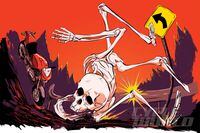Like Las Vegas and lost wages or Harvey Wallbangers and hangovers, bikes and broken bones unfortunately sometimes go together. Unappealing, true, but there’s good news. “Bones are among the only tissues in the body that heal without scarring, returning to normal after a fracture,” says Dr. Chris Proctor, a board-certified orthopedic surgeon based in Santa Barbara, California. “Your bones are constantly breaking down and rebuilding, so the bone structure you had 10 years ago is not the structure you have today.”
We asked Dr. Proctor if humans are innately deficient in bone structure. “No,” he says. “If a bear could ride a bike and collide with a truck, he’d break his leg too. So we aren’t flawed physically; instead our flaw is in the brain. An ancient hunter-gatherer would not break bones because he could only run so fast; bones started breaking when we started going faster.”
Aging does not necessarily make bones brittle, but being female does. “While a 30-year-old male typically has the strongest bones, a man in his 70s still may have no signs of osteopenia or osteoporosis,” Proctor notes. “However, women’s bone densities are typically lower than men’s and vary based on age and race.” To learn your own bone density, ask your doctor to order a test.
Meanwhile here are some strategies for safeguarding your bones.
Lower extremities are most at risk. Bicyclists break their collarbones and snowboarders their wrists. But street riders tend to suffer lower-extremity injuries when they contact a car or truck. This can range from hips to legs, ankles, and toes.
Protect soft tissues. "From an orthopedic standpoint, we can do wonders in repairing bones," Proctor says. "But if you crash wearing shorts and sneakers and grind away the skin, muscles, tendons, and ligaments, those sometimes cannot be fixed."
Armored apparel helps. Wearing armored protective gear will help reduce the forces that can break a bone. But perhaps just as importantly, it can save the soft tissue that surrounds bones and joints from being worn away by asphalt.
Build stronger bones. Lifting weights and doing impact exercises builds stronger bones. "Someone who does weight training or runs is going to have stronger bones than a swimmer," Proctor says. "The more stress on the bones, the stronger they get."











/cloudfront-us-east-1.images.arcpublishing.com/octane/K3R6PGUBF5GS5BDWWZ6FAFIFTU.jpg)
/cloudfront-us-east-1.images.arcpublishing.com/octane/6YTVGET7GJAWRKZFI6FMEUBAHE.jpg)
/cloudfront-us-east-1.images.arcpublishing.com/octane/I7G4VVWN4RHHLHD2PROCYZT5TU.jpg)
/cloudfront-us-east-1.images.arcpublishing.com/octane/3S7JJ3WBO5AC7KKRUX34DI5KQE.jpg)
/cloudfront-us-east-1.images.arcpublishing.com/octane/RO36KTIVYZEATJW7CCB77EQHLQ.jpg)
/cloudfront-us-east-1.images.arcpublishing.com/octane/BUIUXSLF5RFRVJ3E26VRO5V2AY.jpg)
/cloudfront-us-east-1.images.arcpublishing.com/octane/EJJ2JBBSEZAWLFCRDALQOIBFVU.jpg)
/cloudfront-us-east-1.images.arcpublishing.com/octane/WVYKJFMINVFMFH37AE4OUEWVIM.jpg)

/cloudfront-us-east-1.images.arcpublishing.com/octane/JJ3MC6GNDFF5ZNYD3KD3E4EY7Y.jpg)
/cloudfront-us-east-1.images.arcpublishing.com/octane/XH2ETEU4NVGDFNQO2XT2QQS5LU.jpg)
/cloudfront-us-east-1.images.arcpublishing.com/octane/UFG652C27BDBFPK42TDAJ5CMX4.jpg)
/cloudfront-us-east-1.images.arcpublishing.com/octane/AUE3NFVRRZDSBIDVUGIYIDQNUI.jpg)
/cloudfront-us-east-1.images.arcpublishing.com/octane/LYR62CH2WNBMHJJVXVATZHOUE4.jpg)
/cloudfront-us-east-1.images.arcpublishing.com/octane/RBCTRGBQYBDK7A6XPG3HKPS7ZQ.jpg)
/cloudfront-us-east-1.images.arcpublishing.com/octane/MQXQRYMZVBCWJIRYP3HEN3SHVE.jpg)
/cloudfront-us-east-1.images.arcpublishing.com/octane/TSPODNNEWRDSVJGUCNQTDG4ADI.jpg)
/cloudfront-us-east-1.images.arcpublishing.com/octane/X5TB7BDV4BA2RPSY54ZGK27RP4.jpg)
/cloudfront-us-east-1.images.arcpublishing.com/octane/REUHOJXRDBGZ5IHBYZCCBCISPA.jpg)
/cloudfront-us-east-1.images.arcpublishing.com/octane/52LGJTCKBFEHDF7S7H4CVUIMGM.jpg)
/cloudfront-us-east-1.images.arcpublishing.com/octane/YMWAIPIPSJAOXOU3QMJMGH37OM.jpg)


/cloudfront-us-east-1.images.arcpublishing.com/octane/EJ6KZRGAYBCVXNL2PJXL37UVWQ.jpg)